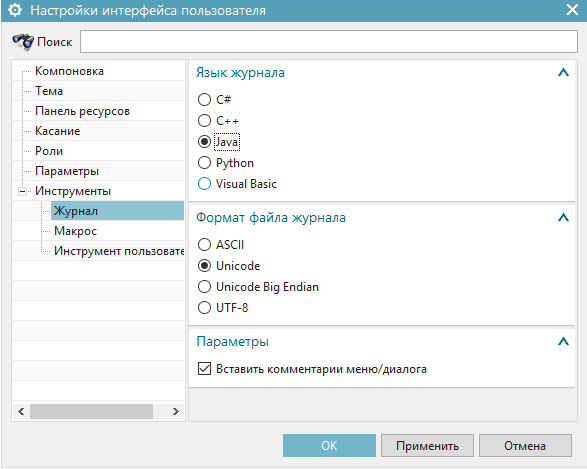Les informations nécessaires sur la bibliothèque NXOpen sont disponibles sur le site officiel .
Le dossier racine NX contient les bibliothèques par défaut dont nous avons besoin, ainsi que des exemples:
- C: \ Program Files \ Siemens \ NX 12.0 \ NXBIN avec l'extension jar
- C: \ Program Files \ Siemens \ NX 12.0 \ UGOPEN avec l'extension jar
- C: \ Program Files \ Siemens \ NX 12.0 \ UGOPEN \ SampleNXOpenApplications \ Java.
Pour simplifier l'écriture de code, vous pouvez utiliser le journal de vos actions dans un fichier texte comme base. Par défaut, Unigraphics NX écrit dans le langage Visual Basic, mais dans les paramètres, vous pouvez le changer en Java ou tout autre dans la liste des disponibles:

Voici un exemple de journalisation dans un fichier texte.
Liste des codes
// NX 12.0.1.7
// Journal created by Aleksandr on Sun Nov 3 19:49:32 2019 RTZ 2 ()
//
import nxopen.*;
public class journalTT
{
public static void main(String [] args) throws NXException, java.rmi.RemoteException
{
nxopen.Session theSession = (nxopen.Session)nxopen.SessionFactory.get("Session");
nxopen.cae.FemPart workFemPart = ((nxopen.cae.FemPart)theSession.parts().baseWork());
nxopen.cae.FemPart displayFemPart = ((nxopen.cae.FemPart)theSession.parts().baseDisplay());
// ----------------------------------------------
// : ->->2D ...
// ----------------------------------------------
int markId1;
markId1 = theSession.setUndoMark(nxopen.Session.MarkVisibility.VISIBLE, "");
nxopen.cae.FEModel fEModel1 = ((nxopen.cae.FEModel)workFemPart.findObject("FEModel"));
nxopen.cae.MeshManager meshManager1 = ((nxopen.cae.MeshManager)fEModel1.find("MeshManager"));
nxopen.cae.Mesh2d nullNXOpen_CAE_Mesh2d = null;
nxopen.cae.Mesh2dBuilder mesh2dBuilder1;
mesh2dBuilder1 = meshManager1.createMesh2dBuilder(nullNXOpen_CAE_Mesh2d);
nxopen.cae.MeshCollector nullNXOpen_CAE_MeshCollector = null;
mesh2dBuilder1.elementType().destinationCollector().setElementContainer(nullNXOpen_CAE_MeshCollector);
mesh2dBuilder1.elementType().setElementTypeName("CQUAD4");
nxopen.Unit unit1 = ((nxopen.Unit)workFemPart.unitCollection().findObject("MilliMeter"));
mesh2dBuilder1.propertyTable().setBaseScalarWithDataPropertyValue("quad mesh overall edge size", "10", unit1);
mesh2dBuilder1.propertyTable().setBooleanPropertyValue("target minimum element edge length", false);
mesh2dBuilder1.propertyTable().setBaseScalarWithDataPropertyValue("surface curvature threshold", "5.05", unit1);
nxopen.Unit nullNXOpen_Unit = null;
mesh2dBuilder1.propertyTable().setBaseScalarWithDataPropertyValue("small feature value", "1", nullNXOpen_Unit);
theSession.setUndoMarkName(markId1, " 2D ");
nxopen.DisplayableObject [] objects1 = new nxopen.DisplayableObject[1];
nxopen.cae.CAEBody cAEBody1 = ((nxopen.cae.CAEBody)workFemPart.findObject("CAE_Body(14)"));
nxopen.cae.CAEFace cAEFace1 = ((nxopen.cae.CAEFace)cAEBody1.findObject("CAE_Face(14)"));
objects1[0] = cAEFace1;
boolean added1;
added1 = mesh2dBuilder1.selectionList().add(objects1);
nxopen.DisplayableObject [] objects2 = new nxopen.DisplayableObject[1];
nxopen.cae.CAEBody cAEBody2 = ((nxopen.cae.CAEBody)workFemPart.findObject("CAE_Body(3)"));
nxopen.cae.CAEFace cAEFace2 = ((nxopen.cae.CAEFace)cAEBody2.findObject("CAE_Face(3)"));
objects2[0] = cAEFace2;
boolean added2;
added2 = mesh2dBuilder1.selectionList().add(objects2);
nxopen.DisplayableObject [] objects3 = new nxopen.DisplayableObject[1];
nxopen.cae.CAEBody cAEBody3 = ((nxopen.cae.CAEBody)workFemPart.findObject("CAE_Body(2)"));
nxopen.cae.CAEFace cAEFace3 = ((nxopen.cae.CAEFace)cAEBody3.findObject("CAE_Face(2)"));
objects3[0] = cAEFace3;
boolean added3;
added3 = mesh2dBuilder1.selectionList().add(objects3);
nxopen.DisplayableObject [] objects4 = new nxopen.DisplayableObject[1];
nxopen.cae.CAEBody cAEBody4 = ((nxopen.cae.CAEBody)workFemPart.findObject("CAE_Body(1)"));
nxopen.cae.CAEFace cAEFace4 = ((nxopen.cae.CAEFace)cAEBody4.findObject("CAE_Face(1)"));
objects4[0] = cAEFace4;
boolean added4;
added4 = mesh2dBuilder1.selectionList().add(objects4);
int markId2;
markId2 = theSession.setUndoMark(nxopen.Session.MarkVisibility.INVISIBLE, "2D ");
theSession.deleteUndoMark(markId2, null);
int markId3;
markId3 = theSession.setUndoMark(nxopen.Session.MarkVisibility.INVISIBLE, "2D ");
mesh2dBuilder1.setAutoResetOption(false);
mesh2dBuilder1.elementType().setElementDimension(nxopen.cae.ElementTypeBuilder.ElementType.SHELL);
mesh2dBuilder1.elementType().setElementTypeName("CQUAD4");
nxopen.cae.DestinationCollectorBuilder destinationCollectorBuilder1;
destinationCollectorBuilder1 = mesh2dBuilder1.elementType().destinationCollector();
destinationCollectorBuilder1.setElementContainer(nullNXOpen_CAE_MeshCollector);
destinationCollectorBuilder1.setAutomaticMode(true);
mesh2dBuilder1.propertyTable().setIntegerPropertyValue("meshing method", 0);
mesh2dBuilder1.propertyTable().setBaseScalarWithDataPropertyValue("quad mesh overall edge size", "10", unit1);
mesh2dBuilder1.propertyTable().setBooleanPropertyValue("block decomposition option bool", false);
mesh2dBuilder1.propertyTable().setBooleanPropertyValue("mapped mesh option bool", false);
mesh2dBuilder1.propertyTable().setIntegerPropertyValue("fillet num elements", 3);
mesh2dBuilder1.propertyTable().setIntegerPropertyValue("num elements on cylinder circumference", 6);
mesh2dBuilder1.propertyTable().setBaseScalarWithDataPropertyValue("element size on cylinder height", "1", unit1);
mesh2dBuilder1.propertyTable().setIntegerPropertyValue("quad only option", 0);
mesh2dBuilder1.propertyTable().setBooleanPropertyValue("mesh individual faces option bool", false);
mesh2dBuilder1.propertyTable().setIntegerPropertyValue("midnodes", 0);
mesh2dBuilder1.propertyTable().setBooleanPropertyValue("geometry tolerance option bool", false);
mesh2dBuilder1.propertyTable().setBaseScalarWithDataPropertyValue("geometry tolerance", "0", unit1);
mesh2dBuilder1.propertyTable().setBooleanPropertyValue("target maximum element edge length bool", false);
mesh2dBuilder1.propertyTable().setBaseScalarWithDataPropertyValue("maximum element edge length", "1", unit1);
mesh2dBuilder1.propertyTable().setBooleanPropertyValue("target minimum element edge length", false);
mesh2dBuilder1.propertyTable().setBooleanPropertyValue("split poor quads bool", false);
mesh2dBuilder1.propertyTable().setBooleanPropertyValue("move nodes off geometry bool", false);
mesh2dBuilder1.propertyTable().setBooleanPropertyValue("max quad warp option bool", false);
mesh2dBuilder1.propertyTable().setBaseScalarWithDataPropertyValue("max quad warp", "5", nullNXOpen_Unit);
mesh2dBuilder1.propertyTable().setBaseScalarWithDataPropertyValue("max jacobian", "5", nullNXOpen_Unit);
mesh2dBuilder1.propertyTable().setBooleanPropertyValue("target element skew bool", false);
mesh2dBuilder1.propertyTable().setBaseScalarWithDataPropertyValue("element skew", "30", nullNXOpen_Unit);
mesh2dBuilder1.propertyTable().setBooleanPropertyValue("max included angle quad option bool", false);
nxopen.Unit unit2 = ((nxopen.Unit)workFemPart.unitCollection().findObject("Degrees"));
mesh2dBuilder1.propertyTable().setBaseScalarWithDataPropertyValue("max included angle quad", "150", unit2);
mesh2dBuilder1.propertyTable().setBooleanPropertyValue("min included angle quad option bool", false);
mesh2dBuilder1.propertyTable().setBaseScalarWithDataPropertyValue("min included angle quad", "30", unit2);
mesh2dBuilder1.propertyTable().setBooleanPropertyValue("max included angle tria option bool", false);
mesh2dBuilder1.propertyTable().setBaseScalarWithDataPropertyValue("max included angle tria", "150", unit2);
mesh2dBuilder1.propertyTable().setBooleanPropertyValue("min included angle tria option bool", false);
mesh2dBuilder1.propertyTable().setBaseScalarWithDataPropertyValue("min included angle tria", "30", unit2);
mesh2dBuilder1.propertyTable().setBooleanPropertyValue("mesh transition bool", false);
mesh2dBuilder1.propertyTable().setBaseScalarWithDataPropertyValue("mesh size variation", "50", nullNXOpen_Unit);
mesh2dBuilder1.propertyTable().setBaseScalarWithDataPropertyValue("surface curvature threshold", "5.05", unit1);
mesh2dBuilder1.propertyTable().setBooleanPropertyValue("alternate feature abstraction bool", false);
mesh2dBuilder1.propertyTable().setBaseScalarWithDataPropertyValue("minimum feature element size", "0.001", unit1);
mesh2dBuilder1.propertyTable().setBaseScalarWithDataPropertyValue("small feature tolerance", "10", nullNXOpen_Unit);
mesh2dBuilder1.propertyTable().setBaseScalarWithDataPropertyValue("small feature value", "1", nullNXOpen_Unit);
mesh2dBuilder1.propertyTable().setBooleanPropertyValue("suppress hole option bool", false);
mesh2dBuilder1.propertyTable().setBaseScalarWithDataPropertyValue("hole diameter tolerance", "0", unit1);
mesh2dBuilder1.propertyTable().setIntegerPropertyValue("hole suppresion point type", 0);
mesh2dBuilder1.propertyTable().setBooleanPropertyValue("merge edge toggle bool", false);
mesh2dBuilder1.propertyTable().setBaseScalarWithDataPropertyValue("edge angle", "15", unit2);
mesh2dBuilder1.propertyTable().setBooleanPropertyValue("quad mesh edge match toggle", false);
mesh2dBuilder1.propertyTable().setBaseScalarWithDataPropertyValue("quad mesh edge match tolerance", "0.02", unit1);
mesh2dBuilder1.propertyTable().setBaseScalarWithDataPropertyValue("quad mesh smoothness tolerance", "0.01", unit1);
mesh2dBuilder1.propertyTable().setBaseScalarWithDataPropertyValue("quad mesh surface match tolerance", "0.001", unit1);
mesh2dBuilder1.propertyTable().setIntegerPropertyValue("quad mesh transitional rows", 3);
mesh2dBuilder1.propertyTable().setBaseScalarWithDataPropertyValue("min face angle", "20", unit2);
mesh2dBuilder1.propertyTable().setIntegerPropertyValue("mesh time stamp", 0);
mesh2dBuilder1.propertyTable().setBaseScalarWithDataPropertyValue("quad mesh node coincidence tolerance", "0.0001", unit1);
mesh2dBuilder1.propertyTable().setIntegerPropertyValue("mesh edit allowed", 0);
mesh2dBuilder1.propertyTable().setIntegerPropertyValue("transition edge seeding", 0);
mesh2dBuilder1.propertyTable().setIntegerPropertyValue("cylinder curved end num elements", 6);
int id1;
id1 = theSession.newestVisibleUndoMark();
int nErrs1;
nErrs1 = theSession.updateManager().doUpdate(id1);
nxopen.cae.Mesh [] meshes1 ;
meshes1 = mesh2dBuilder1.commitMesh();
theSession.deleteUndoMark(markId3, null);
theSession.setUndoMarkName(id1, "2D ");
mesh2dBuilder1.destroy();
// ----------------------------------------------
// : -> ->3
// ----------------------------------------------
// ----------------------------------------------
// : ->->
// ----------------------------------------------
}
public static final int getUnloadOption() { return nxopen.BaseSession.LibraryUnloadOption.IMMEDIATELY; }
}
}Maintenant, il construit un maillage uniquement sur les surfaces spécifiées dans le code, et s'il y en a moins ou plus et que leurs noms diffèrent, alors nx donnera une erreur lors de l'exécution de notre code. Par conséquent, nous devons affiner le code en y ajoutant des exceptions try / catch et trouver un moyen de ne pas nous lier au nombre de faces polygonales.
Je l'ai fait comme ça:
try {
for (int i = 1; i < 20; i++) {
obj="object"+i;
cAEB="cAEBody"+i;
cAEF="cAEFace"+i;
adde="added"+i;
//Object objects = new Object();
nxopen.DisplayableObject [] obj = new nxopen.DisplayableObject[1];
nxopen.cae.CAEBody cAEB = ((nxopen.cae.CAEBody)workFemPart.findObject(("CAE_Body"+"("+i+")")));
nxopen.cae.CAEFace cAEF = ((nxopen.cae.CAEFace)cAEB.findObject("CAE_Face"+"("+i+")"));
obj[0] = cAEF;
boolean adde;
adde = mesh2dBuilder1.selectionList().add(obj);
}
} catch (Exception ex) {Voici le résultat final exécuté dans le programme:
